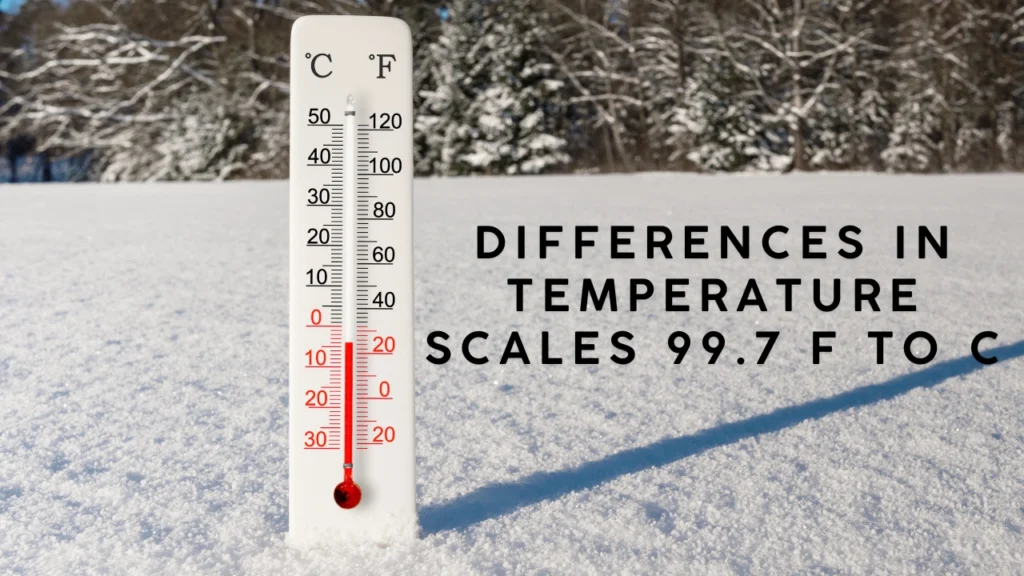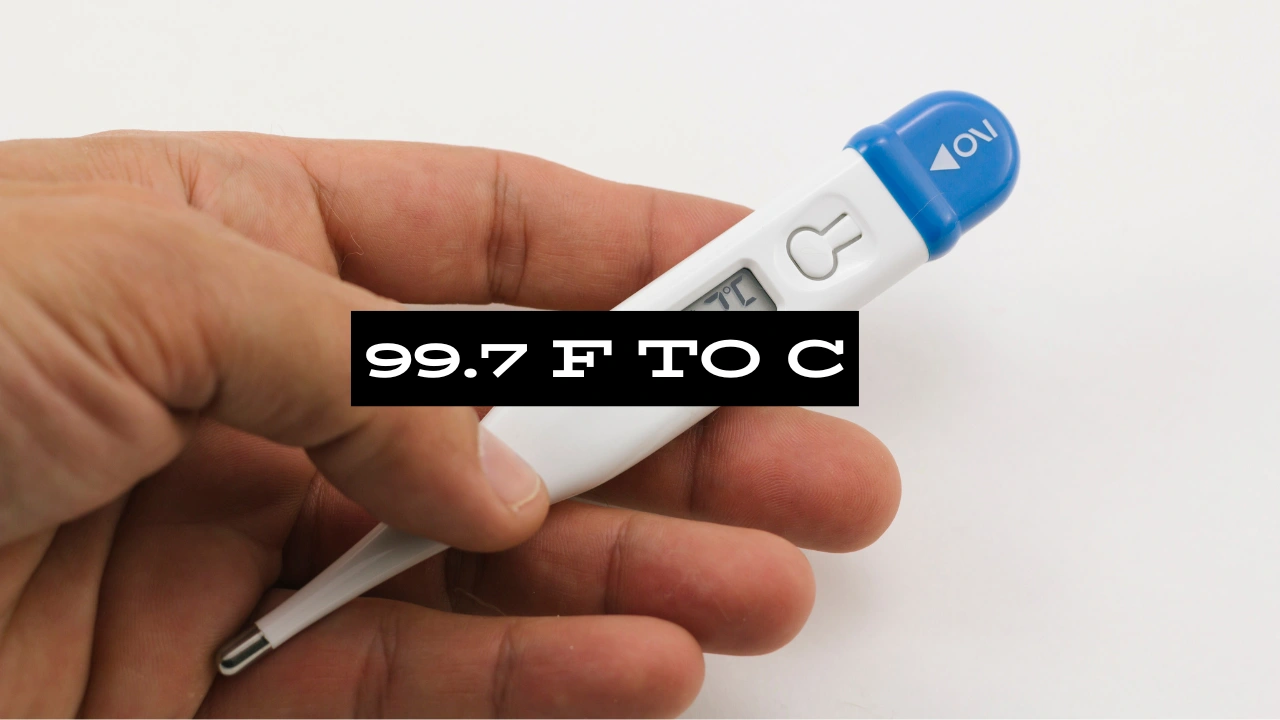99.7 F to C: What It Means and Why It Matters
When dealing with temperature conversions, the task of switching between Fahrenheit (F) and Celsius (C) often arises. Whether you are studying weather patterns, cooking recipes, or assessing medical data, knowing how to accurately convert temperatures is crucial. One such common query is, “What does 99.7 F convert to in Celsius?” Let’s delve deeper to uncover the exact value and the formula behind it.
Why Convert 99.7 F to C?
Temperature conversion is essential for various applications. The Fahrenheit scale is predominantly used in the United States, while Celsius is the standard in most parts of the world. For instance, if your thermometer reads 99.7 F, but you need the equivalent value in Celsius, you’ll need to apply a specific formula. This conversion is particularly relevant in medicine, where body temperature is often measured in Celsius globally. A temperature of 99.7 F could indicate a slight fever, making accurate conversion vital.
Why do we need to convert temperatures like 99.7°F to Celsius?
Temperature is a universal metric, yet the world uses different scales to measure it. While the Fahrenheit scale is commonly used in the United States, the Celsius scale is the standard in most other countries. This disparity creates the need for conversions like 99.7°F to Celsius, ensuring effective communication and accurate interpretation across borders and industries.
Global Differences in Temperature Scales

The Fahrenheit scale, primarily used in the United States and a few other regions, differs significantly from the Celsius scale, which is adopted globally. For example, while a weather report in the U.S. might state a temperature of 99.7°F, the same temperature would be reported as 37.61°C in most other parts of the world. Converting between these scales allows for better global understanding, whether in scientific research, international travel, or even basic conversations.
Medical Contexts: Ensuring Accuracy
In healthcare, the precise interpretation of body temperature is crucial. For example, 99.7°F, a reading on a Fahrenheit thermometer, is a slightly elevated body temperature but not necessarily a fever. In countries using Celsius, medical professionals need to know that this value translates to 37.61°C to make informed decisions. Without this conversion, misunderstandings could lead to incorrect diagnoses or treatments.
Scientific and Educational Relevance
In science and education, Celsius is the preferred unit due to its simplicity and alignment with the metric system. Many experiments, calculations, and studies require data in Celsius, even if collected in Fahrenheit. Converting temperatures like 99.7°F to Celsius ensures consistency in scientific literature, fostering collaboration across regions.
Practical Applications in Daily Life
Everyday scenarios also demand temperature conversions. Recipes, for instance, often list oven temperatures in Fahrenheit in American cookbooks but in Celsius elsewhere. Similarly, travelers might encounter weather forecasts in a different scale than what they are accustomed to. Converting 99.7°F to Celsius helps maintain consistency and prevent confusion, making such activities smoother.
Bridging Cultural and Systemic Gaps
The need to convert temperatures goes beyond numbers—it’s about communication. A temperature like 99.7°F might seem normal to someone accustomed to Fahrenheit but could require clarification for those who think in Celsius. By converting temperatures, we bridge cultural and systemic gaps, ensuring everyone speaks the same “language” of temperature.
A Universal Skill
Converting temperatures like 99.7°F to Celsius is more than a technical exercise; it’s a practical skill that enhances clarity and precision in various fields. Whether you’re managing your health, interpreting scientific data, or navigating everyday situations, understanding how and why to convert temperatures is essential in a connected world.
The Formula for Conversion
To convert 99.7 F to C, the formula is:
[
\text{Celsius (C)} = \frac{(\text{Fahrenheit (F)} – 32)}{1.8}
]
Using this formula, let’s calculate step by step:
- Subtract 32 from 99.7: ( 99.7 – 32 = 67.7 )
- Divide the result by 1.8: ( 67.7 \div 1.8 \approx 37.61 )
Thus, 99.7 F converts to approximately 37.61 C.
Practical Applications of the Conversion
1. Medical Relevance
Body temperature is a key health indicator. In Celsius, the normal range is 36.1°C to 37.2°C. A temperature of 99.7 F, or 37.61°C, suggests a mild fever. This conversion is essential for international travelers or medical professionals working across countries.
2. Cooking and Baking
Recipes often provide temperatures in Celsius or Fahrenheit, depending on the country of origin. If a recipe calls for a temperature near 99.7 F, precise conversion ensures successful results.
3. Weather Reports
Many scientific studies and international weather forecasts use Celsius. Understanding conversions like 99.7 F to C allows better interpretation of data.
Historical Context: Fahrenheit vs. Celsius
The Fahrenheit scale, developed by Daniel Gabriel Fahrenheit in 1724, is still widely used in the United States. On the other hand, the Celsius scale, introduced by Anders Celsius, is the international standard. While the two systems serve the same purpose, the conversion between them often causes confusion, especially when dealing with specific values like 99.7°F to Celsius.
Comparison of Fahrenheit and Celsius
The two scales differ significantly. To understand how 99.7 F to C fits within both, here’s a quick comparison:
| Temperature (°F) | Temperature (°C) | Application |
|---|---|---|
| 98.6 F | 37.0 C | Average human body temp |
| 99.7 F | 37.61 C | Mild fever |
| 100.4 F | 38.0 C | Moderate fever |
Tips for Remembering the Conversion
Converting temperatures like 99.7 F to C can be tricky, but with practice, it becomes second nature. Here are some useful tips:
- Memorize key benchmarks: Water freezes at 0°C (32°F) and boils at 100°C (212°F).
- Use the formula repeatedly to internalize the steps.
- Consider a digital converter or smartphone app for quick results.
The Importance of Precision in Conversion
Temperature readings like 99.7 F to C may seem trivial, but slight differences can have significant implications. In healthcare, even minor deviations in body temperature can influence diagnosis. Similarly, in scientific experiments, accurate conversions ensure reliable outcomes.
Common Misconceptions About the Scales
Many assume that Fahrenheit and Celsius scales are interchangeable or equally spaced. However, a 1°F change does not equate to a 1°C change. The conversion formula accounts for these differences, ensuring that values like 99.7 F to C are precise.
Why Both Scales Exist
Fahrenheit, developed by Daniel Gabriel Fahrenheit in 1724, was widely adopted in English-speaking countries for its precision. Celsius, introduced later, is simpler due to its 0° and 100° benchmarks for freezing and boiling points of water. Today, Celsius dominates globally, with Fahrenheit persisting mainly in the U.S.
Conclusion
Understanding how to convert 99.7 F to C is more than just a mathematical exercise; it bridges communication across different systems. Whether for health, cooking, or weather, knowing the equivalent of 99.7 F in Celsius (37.61°C) ensures accuracy and fosters global understanding. The next time you encounter a Fahrenheit reading, you’ll know exactly how to convert it!



